General, Sir John Monash, Personal Files Book 23, 1 June - 23 September 1919- Part 2
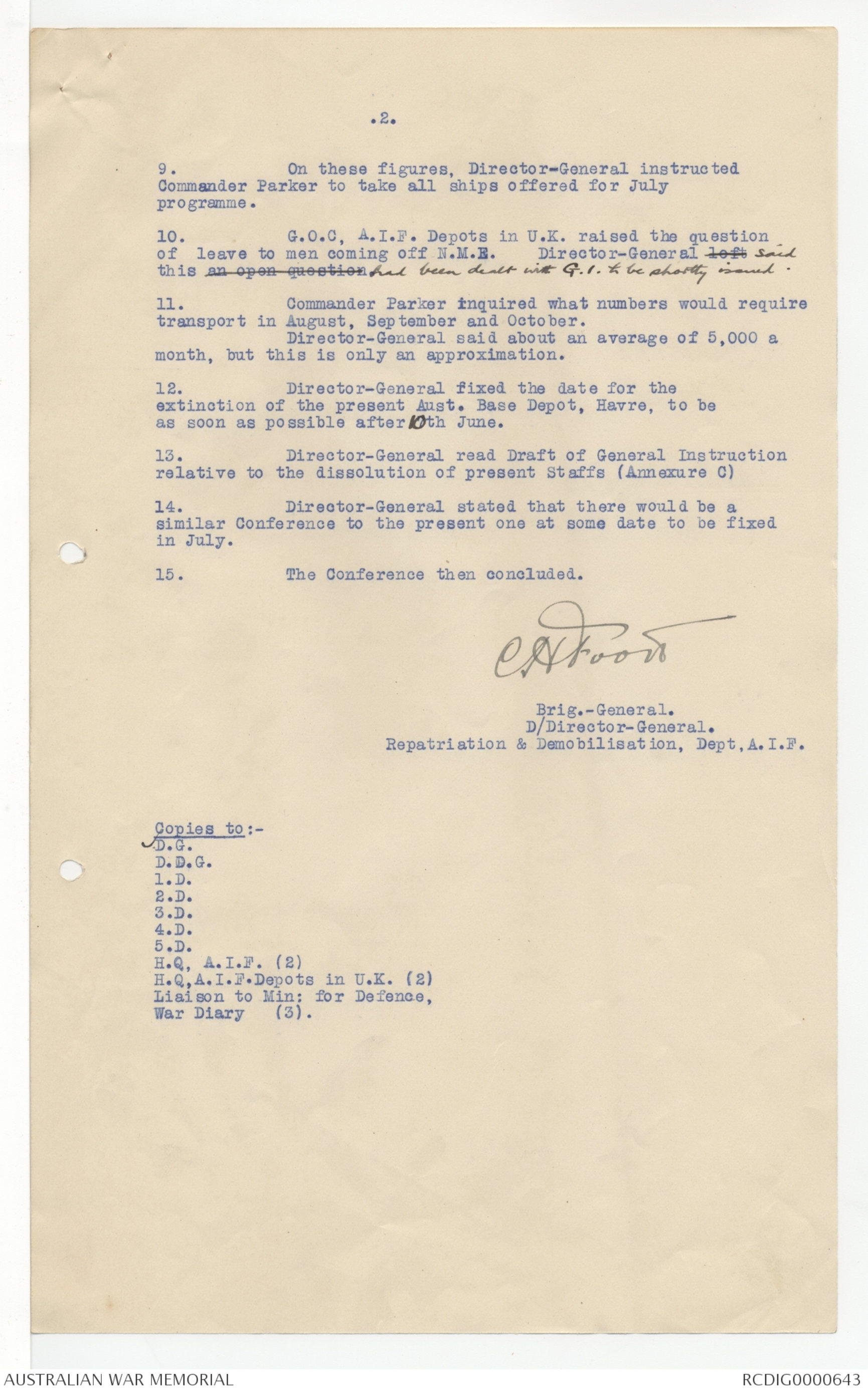
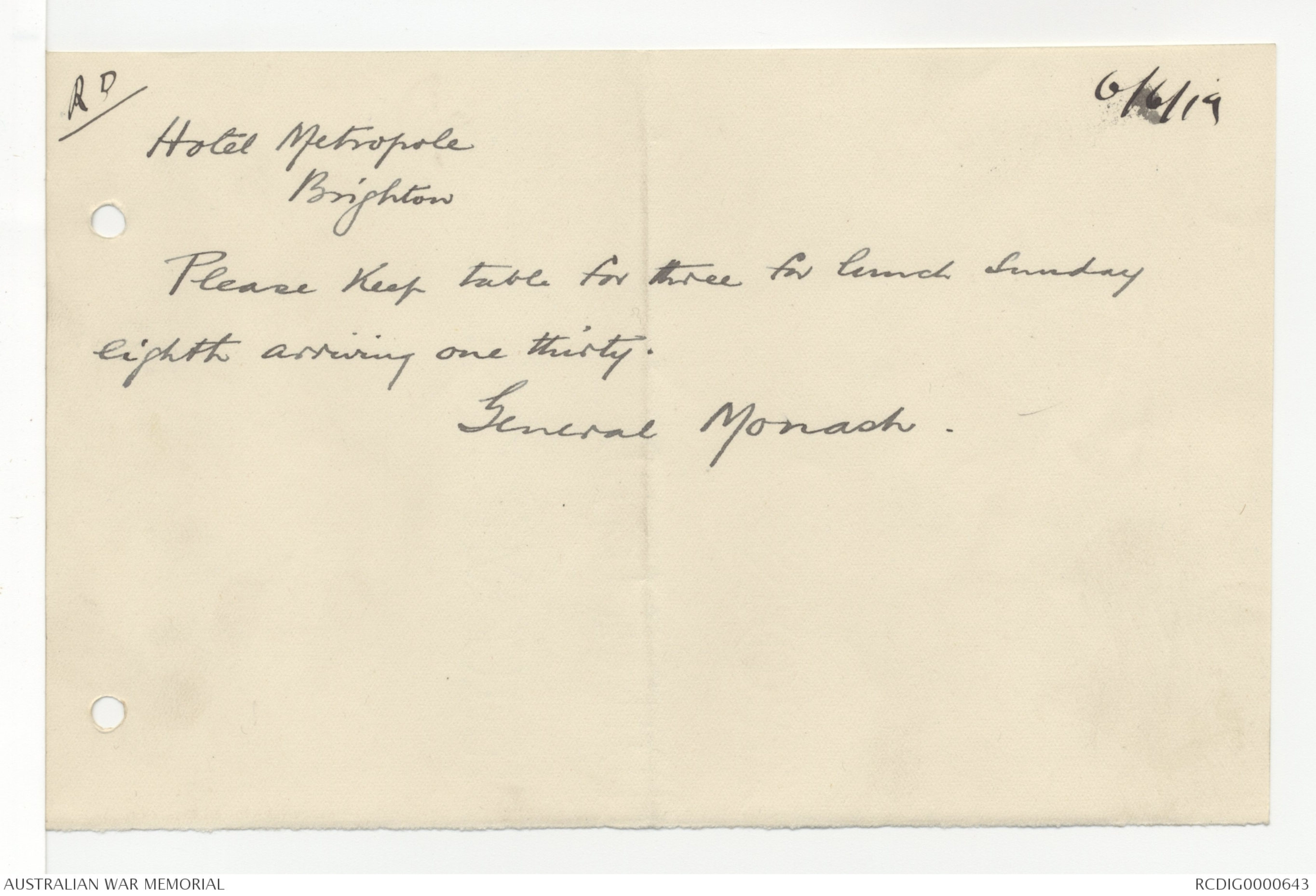
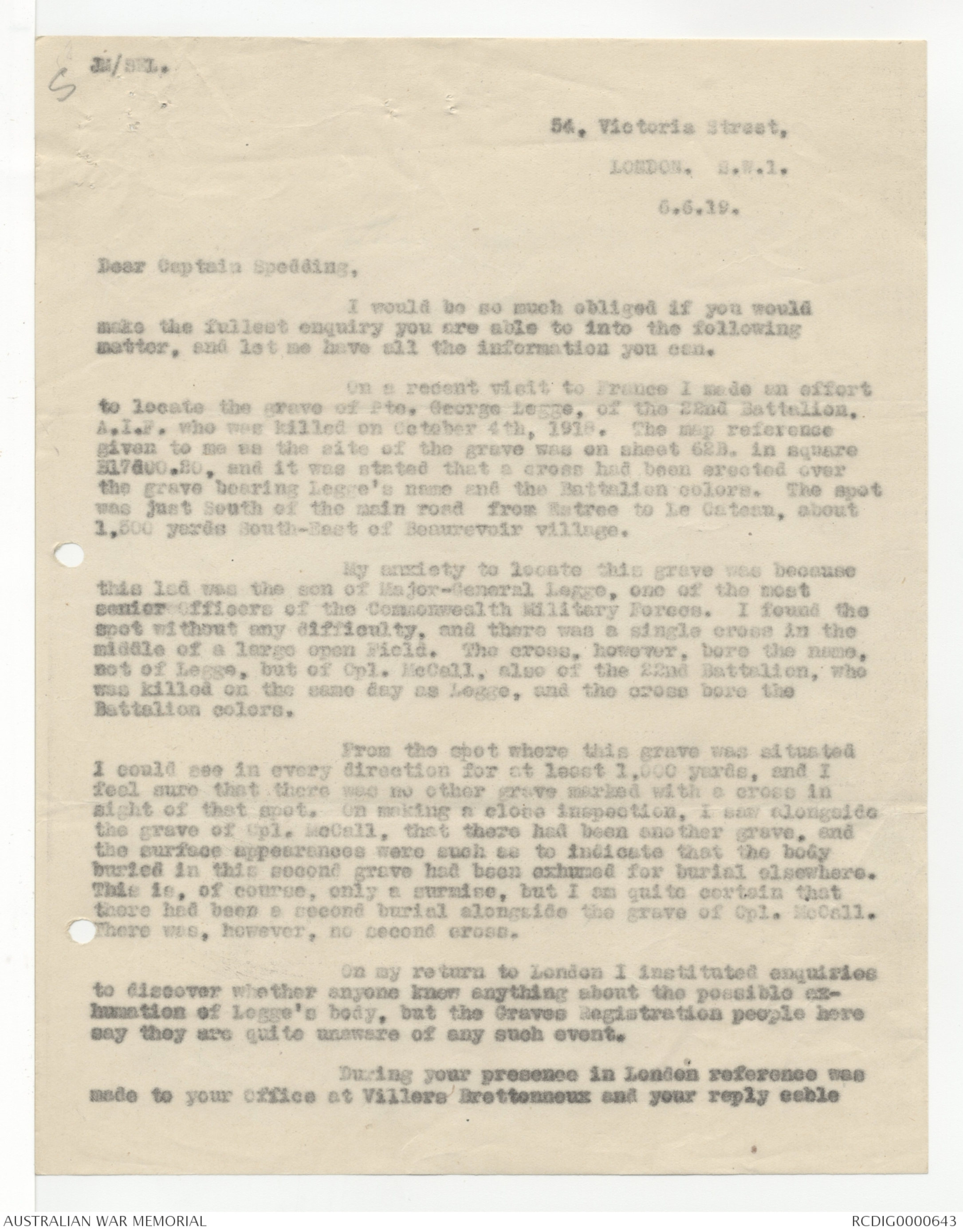
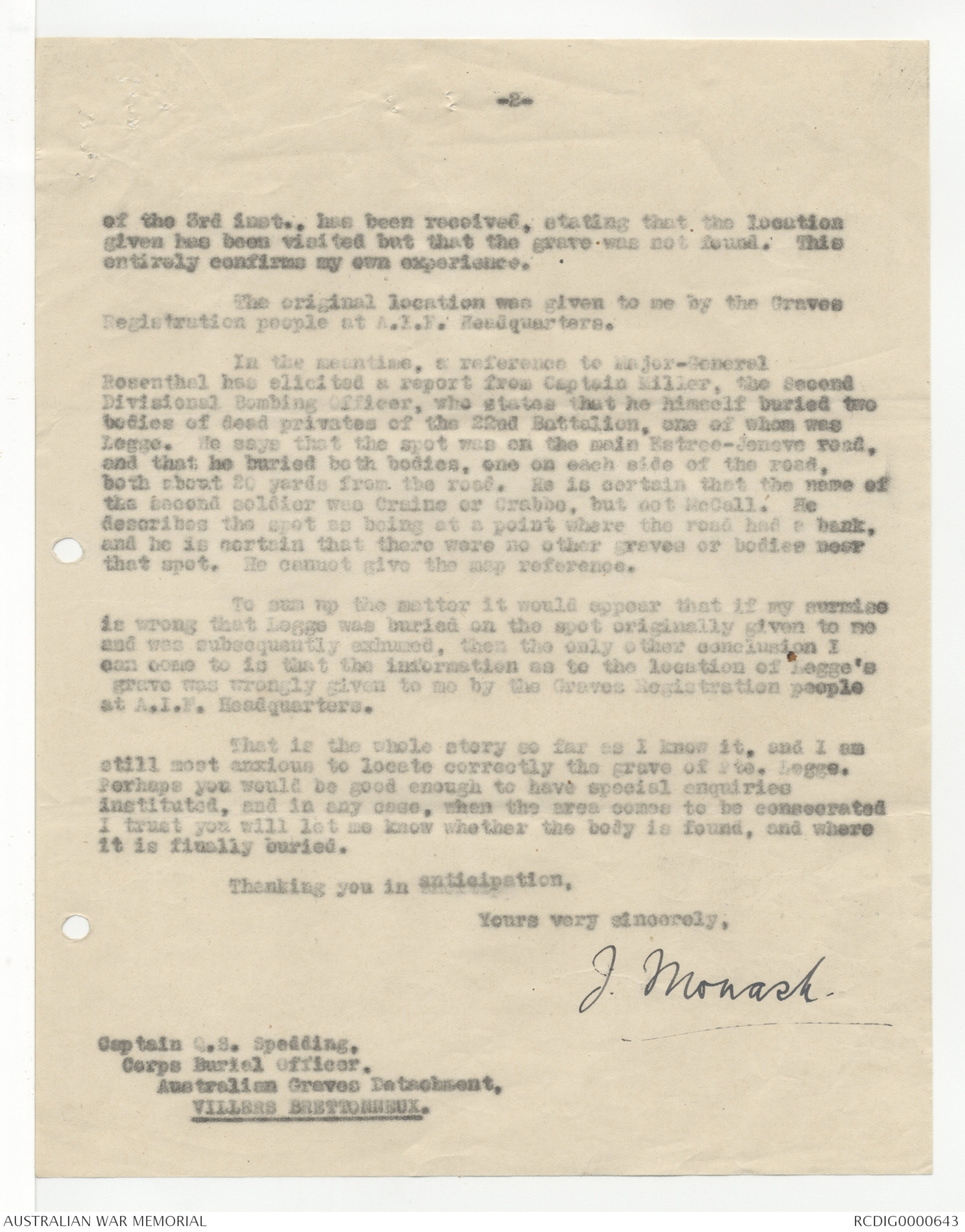
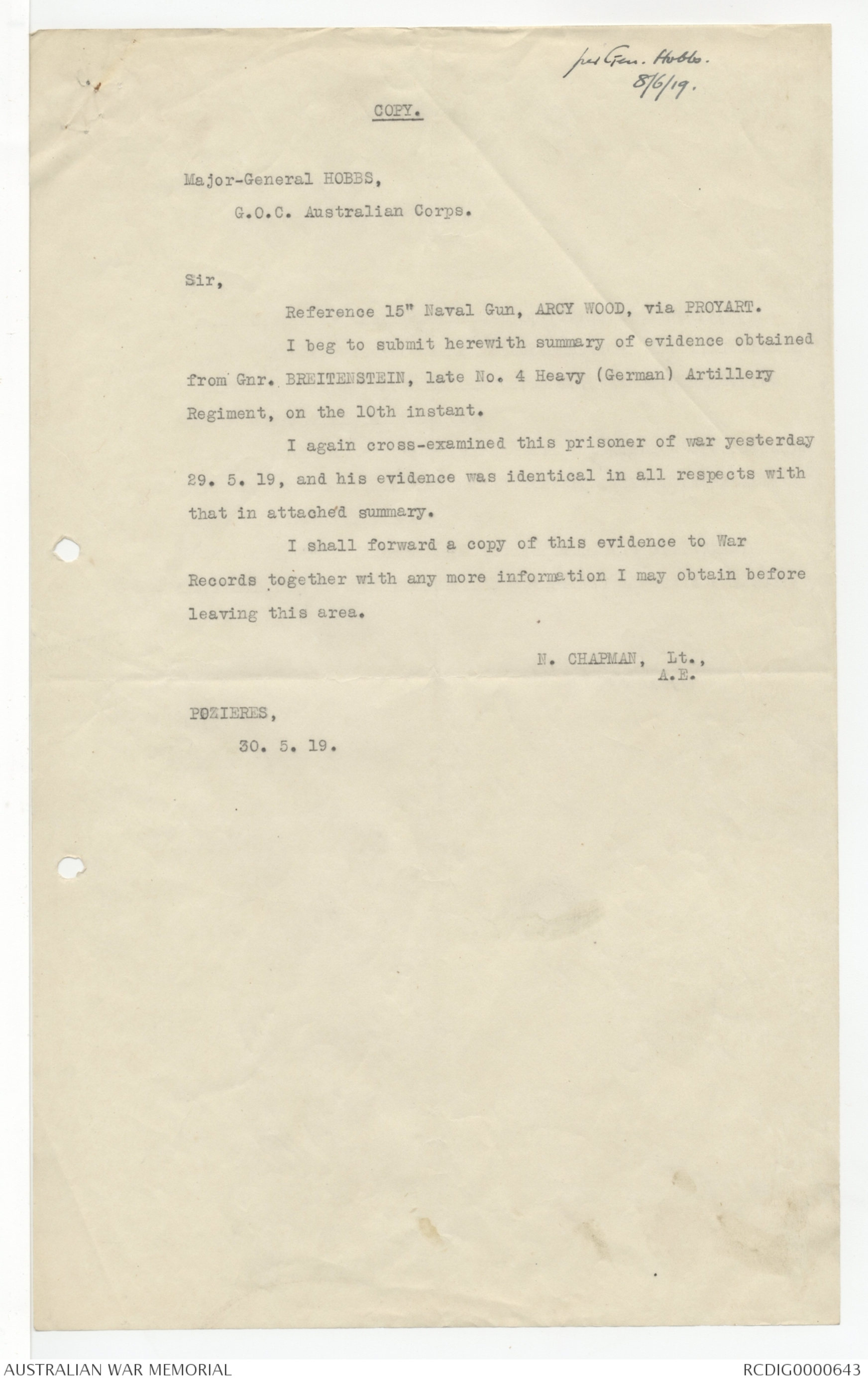

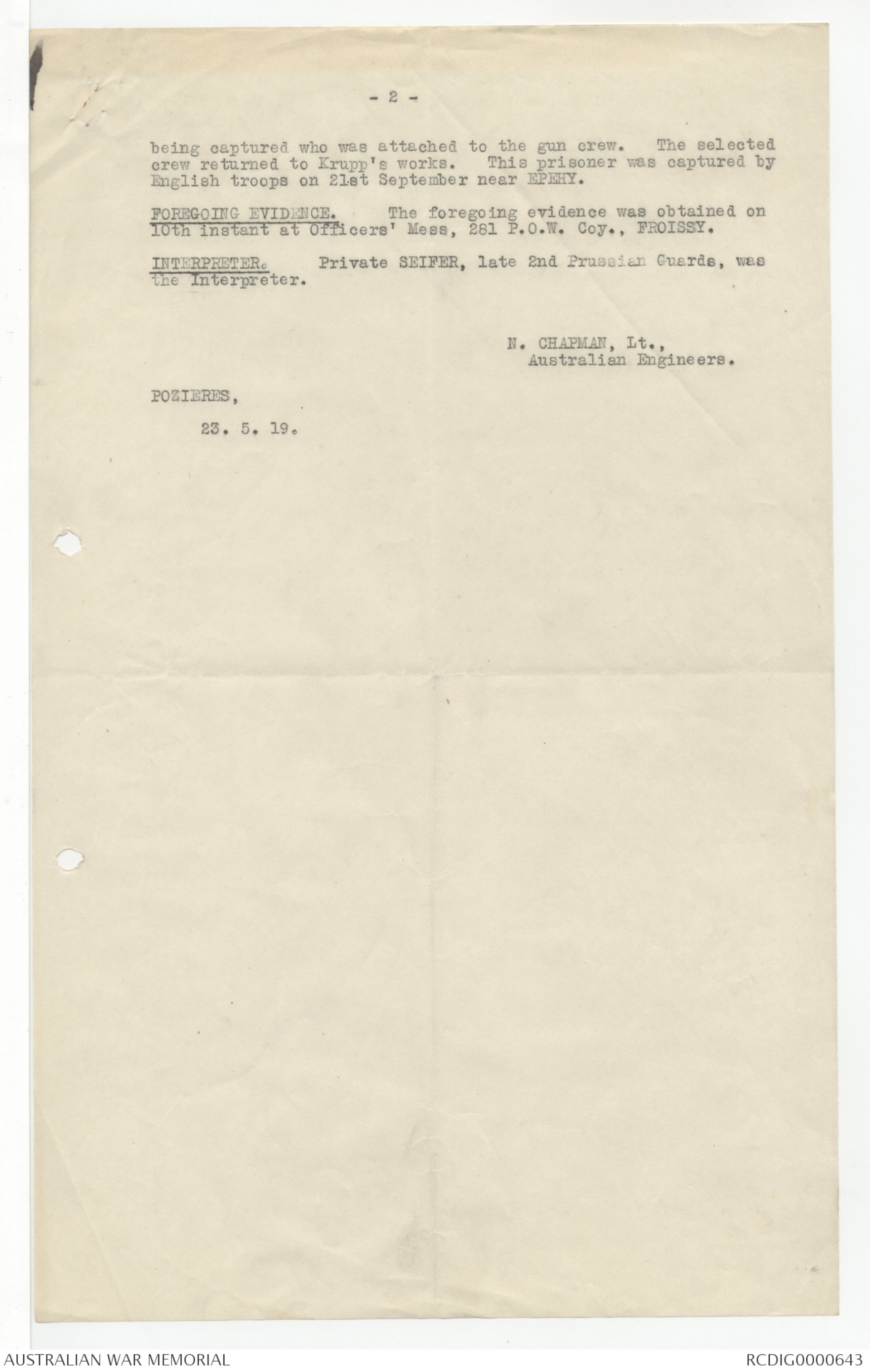
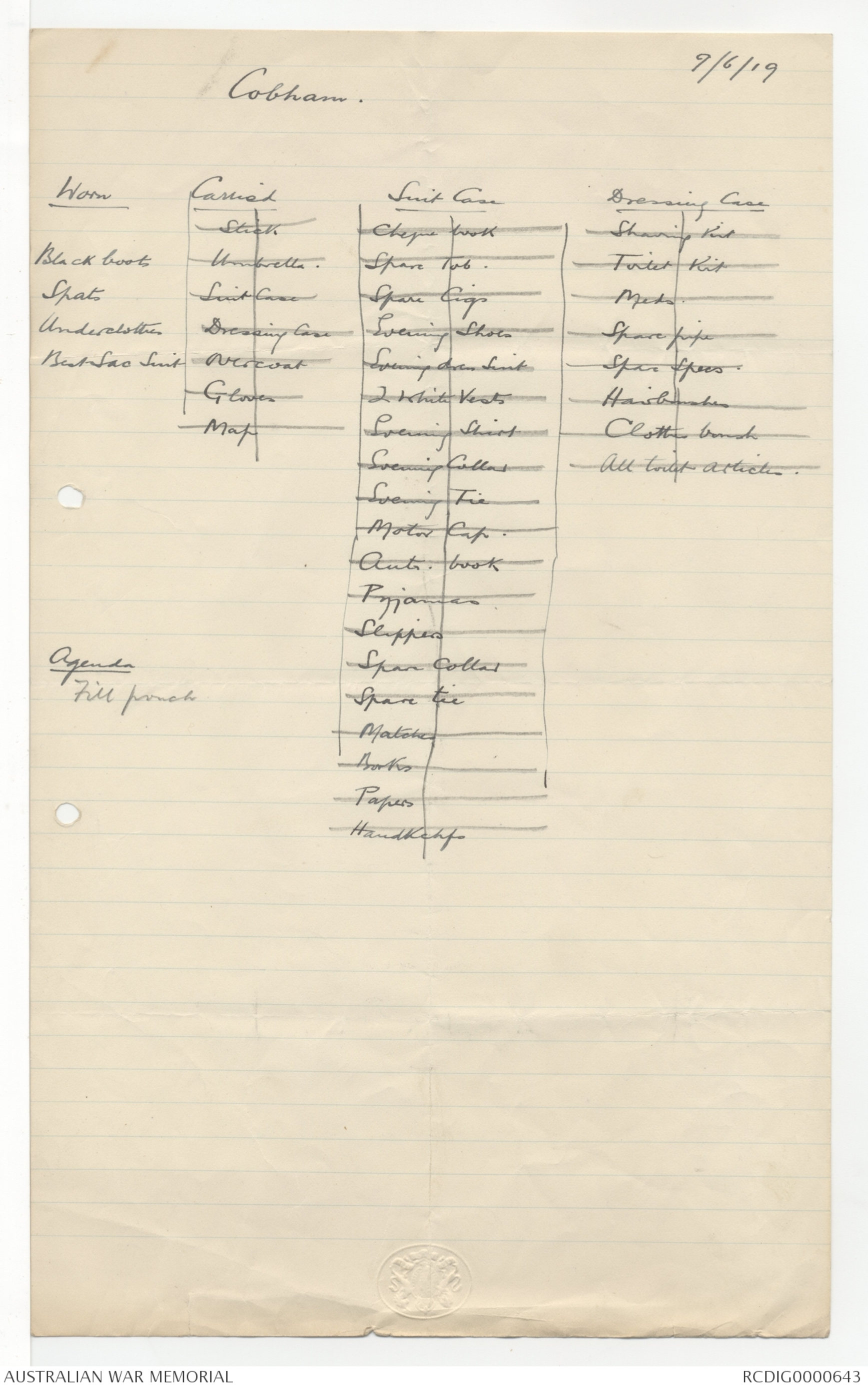
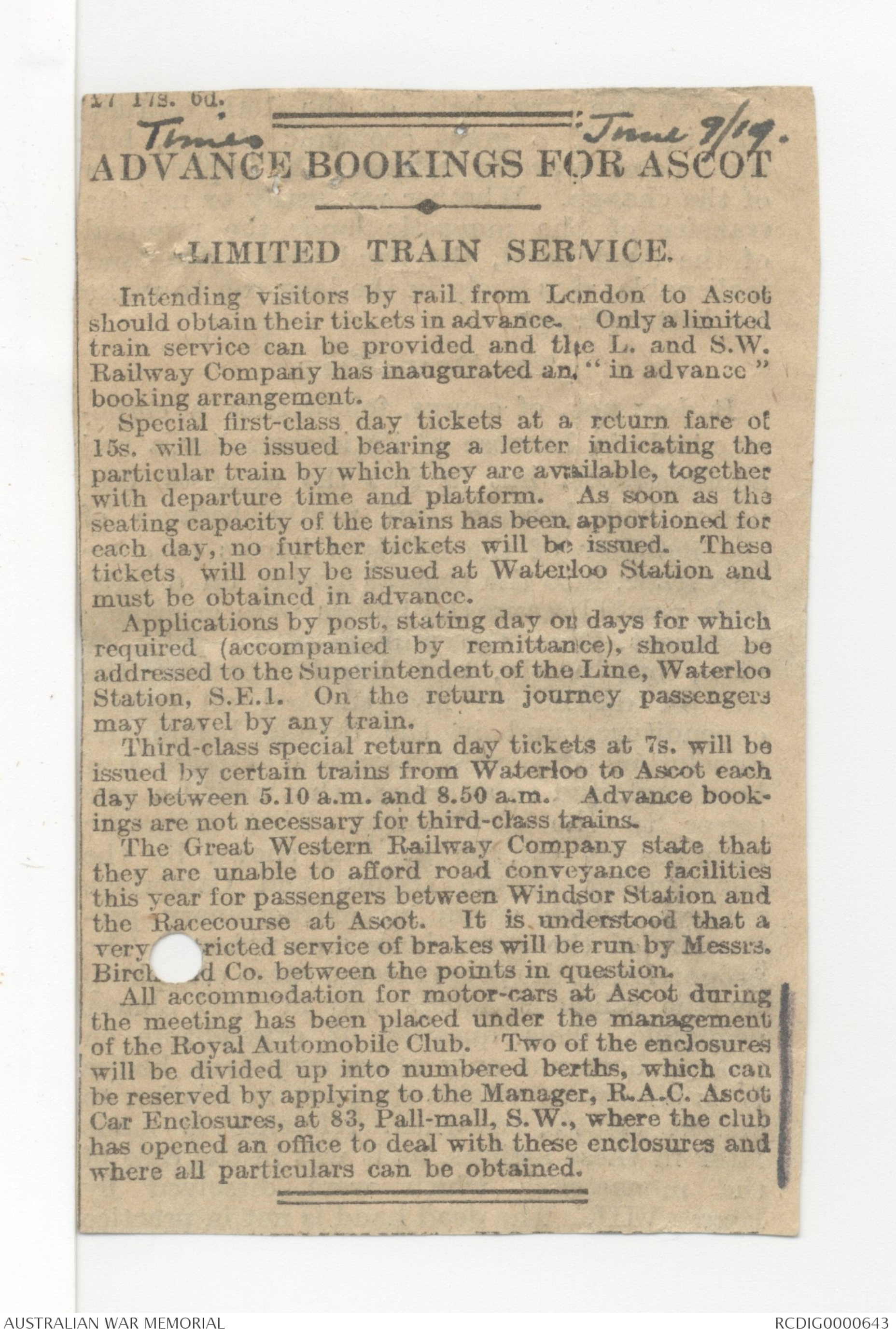
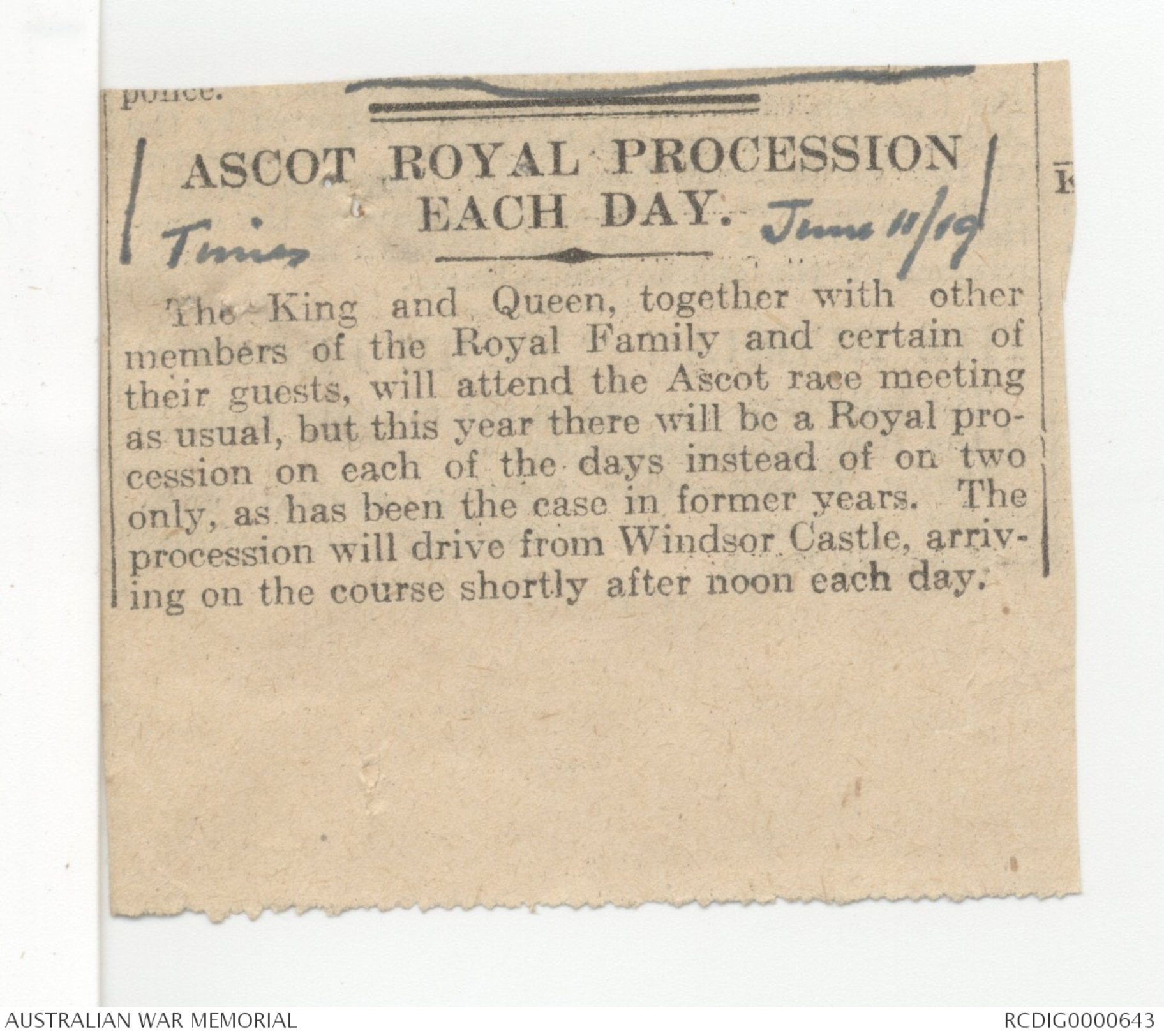
.2.
9. On these figures, Director-General instructed
Commander Parker to take all ships offered for July
programme.
10. G.O.C, A.I.F. Depots in U.K. raised the question
of leave to men coming off N.M.E. Director-General left said
this an open question had been dealt with G.I. to be shortly issued.
11. Commander Parker inquired what numbers would require
transport in August, September and October.
Director-General said about an average of 5,000 a
month, but this is only an approximation.
12. Director-General fixed the date for the
extinction of the present Aust. Base Depot, Havre, to be
as soon as possible after 10th June.
13. Director-General read Draft of General Instruction
relative to the dissolution of present Staffs (Annexure C)
14. Director-General stated that there would be a
similar Conference to the present one at some date to be fixed
in July.
15. The Conference then concluded.
C H Boon
Brig.-General.
D/Director-General.
Repatriation & Demobilisation, Dept, A.I.F.
Copies to:
D.G
D.D.G.
1.D.
2.D.
3.D.
4.D.
5.D.
H.Q, A.I.F. (2)
H.Q, A.I.F. Depots in U.K. (2)
Liaison to Min: for Defence,
War Diary (3).
6/6/19
RD
Hotel Metropole
Brighton
Please keep table for three for lunch Sunday
eighth arriving one thirty.
General Monash
[[*S*]]
JM/SKL
54, Victoria Street,
LONDON, S.W.1.
6.6.19.
Dear Captain Spedding,
I would be so such obliged if you would
make the fullest enquiry you are able to into the following
matter, and let me have all the information you can.
On a recent visit to France I made an effort
to locate the grave of Pte. George Legge, of the 22nd Battalion.
A.I.F. who was killed on October 4th, 1918. The map reference
given to me as the site of the grave was on sheet 62B. in square
B17800.20, and it was stated that a cross had been erected over
the grave bearing Legge's name and the Battalion colors. The spot
was just South of the main road from Estree to Le Cateau, about
1,500 yards South-East of Beaurevoir village.
My anxiety to locate this grave was because
this lad was the son of Major-General Legge, one of the most
senior officers of the Commonwealth Military Forces. I found the
spot without any difficulty, and there was a single cross in the
middle of a large open Field. The cross, however, bore the name,
not of Legge, but of Cpl. McCall, also of the 22nd Battalion, who
was killed on the same day as Legge, and the cross bore the
Battalion colors.
From the spot where this grave was situated
I could see in every direction for at least 1,000 yards, and I
feel sure that there was no other grave marked with a cross in
sight of that spot. On making a close inspection, I saw alongside
the grave of Cpl. McCall, that there had been another grave, and
the surface appearances were such ss to indicate that the body
buried in this second grave had been exhumed for burial elsewhere.
This is, of course, only a surmise, but I am quite certain that
there had been a second burial alongside the grave of Cpl. McCall.
There was, however, no second cross.
On my return to London I instituted enquiries
to discover whether anyone knew anything about the possible exhumation
of Legge's body, but the Graves Registration people here
say they are quite unaware of any such event.
During your presence in London reference was
made to your Office at Villers Brettonneux and your reply cable
of the 3rd inst.. has been received, stating that the location
given has been visited but that the grave was not found. This
entirely confirms my own experience.
The original location was given to me by the Graves
Registration people at A.l.F. Headquarters.
In the meantime, a reference to Major-General
Rosenthal has elicited a report from Captain Miller, the Second
Divisional Bombing Officer, who states that he himself buried two
bodies of dead privates of the 22nd Battalion, one of whom was
Legge. He says that the spot was on the main Estree-Jeneve road,
and that he buried both bodies, one on each side of the road,
both about 20 yards from the road. He is certain that the name of
the second soldier was Craine or Crabbe, but not McCall. He
describes the spot as being at a point where the road had a bank,
and he is certain that there were no other graves or bodies near
that spot. He cannot give the map reference.
To sum up the matter it would appear that if my surmise
is wrong that Legge was buried on the spot originally given to me
and was subsequently exhumed, then the only other conclusion I
can come to is that the information as to the location of Legge's
grave was wrongly given to me by Graves Registration people
at A.I.F. Headquarters.
That is the whole story so far as I know it, and I am
still most anxious to locate correctly the grave of Pte. Legge.
Perhaps you would be good enough to have special enquiries
instituted, and in any case, when the area comes to be consecrated
I trust you will let me know whether the body is found, and where
it is finally buried.
Thanking you in anticipation,
Yours very sincerely,
J. Monash
Captain C.S. Spedding.
Corps Burial Officer,
Australian Graves Detachment,
VILLERS BRETTONNEUX
PER Gen. Hobbs.
8/6/19.
COPY.
Major-General HOBBS,
G.O.C. Australian Corps.
Sir,
Reference 15" Naval Gun, ARCY WOOD, via PROYART.
I beg to submit herewith summary of evidence obtained
from Gnr. BREITENSTEIN, late No. 4 Heavy (German) Artillery
Regiment, on the 10th instant.
I again cross-examined this prisoner of war yesterday
29.5.19, and his evidence was identical in all respects with
that in attached summary.
I shall forward a copy of this evidence to War
Records together with any more information I may obtain before
leaving this area.
N. CHAPMAN, Lt.,
A.E.
POZIERES,
30.5.19.
COPY.
REFERENCE 15" ENEMY GUN, ARCY WOOD VIA PROYART.
Following is summary of evidence obtained from Gnr.
BREITENSTEIN late No. 4 (German) Heavy Artillery Regiment:-
GUN'S HISTORY. This prisoner states that the gun came from
Krupp's works, Essen. Work was started on the gun position
early in April, 1918. A double broad gauge line was laid to
the site while the gun pit was being excavated. Material for
the gun's construction was then brought up by rail. The gun
was completed and ready for action on the morning of 2nd June.
The traversing, elevating and loading was operated by an electric
plant, part of which still exists. The gun was used continuously
fromz2nd June to 28th June. Its maximum firing capacity was 28
rounds per day. This was sometimes reached, but on other days
as few as 3 rounds have been fired. On 28th June the piece
(barrel) being worn out was cut in three - to facilitate removal
and transport - and taken away by train. The prisoner could not
say definitely how many shots were fired during this period -
2nd June to 28th June - but fancies 250 to 300 rounds should be a
fairly reliable estimate. The new piece did not arrive until
6 a.m. 7th August. It was in position at 7 p.m. It fired its
first shot at 2 a.m. on the morning of 8th August and fired
continuously until 7 a.m. 9th August, firing 35 rounds in all.
During the last 24 hours 32 were fired, thus exceeding what was
previously taken as the maximum capacity, viz. 28 rounds per day.
Immediately after the last shot - 7 a.m. 9th August - all shella
were reloaded on trucks. At the same time a party of the gun
crew removed all the smaller - but important and valuable - gun
accessories, while others prepared the gun for demolition. The
train moved away about 8.30 a.m. with the shells, gun accessories
and most of the crew. The few of the crew left behind completed
the laying of the charges by 9 a.m. The electric plant was
destroyed at this time by fire and the gun blown up a few minutes
later. Two large charges were used; one in the breech end of
the bore (the breech was closed) and another immediately
underneath on the gun mounting. These charges were exploded almost
simultaneously and were fired by fuse, not electrically.
GUN CREW. The gun crew was commanded by an Artillery Captain
and consisted of 25 Engineers from Krupp's works. These men
were sworn to secrecy and would only speak in very vague terms
about the gun. Half the crew were always on duty.
CAMOUFLAGE. Great care was taken to conceal the gun position
from aerial observation. A large area was completely covered
and surrounded with camouflage, so that the position could not be
observed either from above or laterally.
TARGETS. The gun was fired by map and assisted by aerial
observation. The city of AMIENS was the principal target, for
which a range of 33 kilometres was used. Many villages of lesser
range were also engaged. The maximum range of the gun was
38 kilometres.
SHELL. The shell was 38 centimetres diameter. Other accurate
dimensions not known. The cartridge case was of brass and about
1 metre long.
PROPELLANT. The propellant was just the same as used for
smaller calibre guns.
PRISONER'S HISTORY. The prisoner, Gnr. BREITENSTEIN, 4th
Heavy Artillery Regiment, was with his battery near DOMPIERRE,
in what he terms the Second Artillery Line, while the gun was
under construction. He was attached to the 15" gun 2nd August to
9th August, and engaged unloading shells from train.
He left with the gun crew, as previously mentioned, about 8.30 a.m. on
the morning of 9th August. He heard the report of the explosion
shortly after 9 a.m. This prisoner does not know anyone else
- 2 -
being captured who was attached to the gun crew. The selected
crew returned to Krupp's works. This prisoner was captured by
English troops on 21st September near EPEHY.
FOREGOING EVIDENCE. The foregoing evidence was obtained on
10th instant at Officers' Mess, 281 P.O.W. Coy., FROISSY.
INTERPRETER. Private SEIFER, late 2nd Prussian Guards, was
the Interpreter.
N. CHAPMAN, Lt.,
Australian Engineers.
POZIERES,
23. 5. 19.
9/6/19
Cobham.
| Worn | Carried | Suit Case | Dressing Case |
| Stick | Cheque book | Shaving Kit | |
| Black boots | Umbrella. | Spare Tob. | Toilet Kit |
| Spats | Suit Case | Spare Cigs | Meds. |
| Underclothes | Dressing Case | Evening Shoes | Spare pipe |
| Best Sac Suit | Overcoat | Evening dress Suit | Spare Specs. |
| Gloves | 2 White Vests | Hairbrushes | |
| Map | Evening Shirt | Clothes brush | |
| Evening Collar | All toilet articles | ||
| Evening Tie | |||
| Motor Cap | |||
| Auto. book | |||
| Pyjamas | |||
| Slippers | |||
| Agenda | Spare Collar | ||
| Fill pouch | Spare Tie | ||
| Matches | |||
| Books | |||
| Papers | |||
| Handkerchfs |
June 9/19
£7 17s. 6d.
Times
ADVANCE BOOKINGS FOR ASCOT
LIMITED TRAIN SERVICE.
Intending visitors by rail from London to Ascot
should obtain their tickets in advance. Only a limited
train service can be provided and the L. and S.W.
Railway Company has inaugurated an "in advance"
booking arrangement.
Special first-class day tickets at a return fare of
15s. will be issued bearing a letter indicating the
particular train by which they are available, together
with departure time and platform.. As soon as the
seating capacity of the trains has been apportioned for
each day, no further tickets will be issued. These
tickets, will only be issued at Waterloo Station and
must be obtained in advance.
Applications by post, stating day or days for which
required (accompanied by remittance), should be
addressed to the Superintendent of the Line, Waterloo
Station, S.E.1. On the return journey passengers
may travel by any train.
Third-class special return day tickets at 7s. will be
issued by certain trains from Waterloo to Ascot each
day between 5.10 a.mn. and 8.50 a.m. Advance bookings
are not necessary for third-class trains.
The Great Western Railway Company state that
they are unable to afford road conveyance facilities
this year for passengers between Windsor Station and
the Racecourse at Ascot. It is understood that a
very restricted service of brakes will be run by Messrs.
Birch and Co. between the points in question.
All accommodation for motor-cars at Ascot during
the meeting has been placed under the management
of the Royal Automobile Club. Two of the enclosures
will be divided up into numbered berths, which can
be reserved by applying to the Manager, R.A.C. Ascot
Car Enclosures, at 83, Pall-mall, S.W., where the club
has opened an office to deal with these enclosures and
where all particulars can be obtained.
ASCOT ROYAL PROCESSION
EAOH DAY. June 11/19
Times
The-King and Queen, together with other
members of the Royal Family and certain of
their guests, will attend the Ascot race meeting
as usual, but this year there will be a Royal procession
on each of the days instead of on two
only, as has been the case in former years. The
procession will drive from Windsor Castle, arriving
on the course shortly after noon each day.
 Sam scott
Sam scottThis transcription item is now locked to you for editing. To release the lock either Save your changes or Cancel.
This lock will be automatically released after 60 minutes of inactivity.